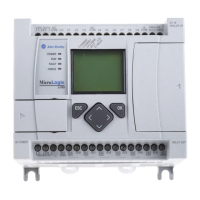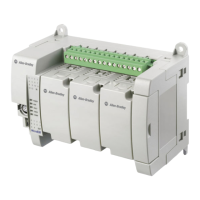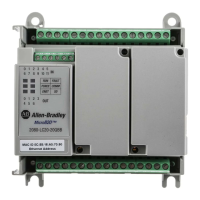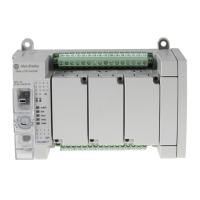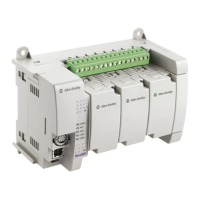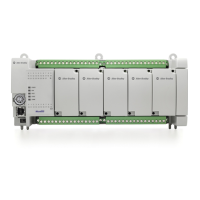(EN)
(DN)
(ER)
MSG
READ/WRITE MESSAGE
Read/write
Target Device
Control Block
Control Block Length 7
Using the Message Instruction
13–3
Message Instruction (MSG)
The MSG is an output instruction that allows the controller to initiate an exchange
of data with other devices. The relationship with the other devices can be either
peer-to-peer communication or master-to-slave communication. The type of
communication required by a particular application determines the programming
configuration requirements of the MSG instruction.
➀
This
only includes the amount of time needed to set up the operation requested. It does not include the time it
takes to service the actual communication, as this time varies with each network configuration. As an example,
144ms is the actual communication service time for the following configuration: 3 nodes on DH-485
(2=MicroLogix 1000 programmable controllers and 1=PLC-500 A.I. Series
programming software), running at
19.2K baud, with 2 words per transfer
.
Entering Parameters
After
you place the MSG instruction on a rung, specify whether the message is to be
a read or write. Then specify the target device and the control block for the MSG
instruction.
• Read/Write – read indicates that the local processor (processor in which the
instruction is located) is receiving data; write indicates that the processor is
sending data.
• Target Device
– identifies the type of command used to establish
communication. The target device can be a MicroLogix 1000 controller or SLC
family processor using SLC commands, or a common interface file by selecting
the CIF format. Valid options are:
– SLC500/ML1000 – Allows communication between a MicroLogix 1000
controller and any other MicroLogix 1000 controller or SLC 500 family
processor.
– 485CIF – (common interface file) Allows communication between a
MicroLogix 1000 controller and a non-MicroLogix 1000/SLC 500 device.
The CIF data is automatically delivered to integer file 9 in SLC 500
processors or file 7 in MicroLogix 1000 controllers. The 485CIF protocol
is also used for PLC-2 type messages to PLC-5 processors.
Programming
Execution Times
(µsec) when:
True False
180
➀
48
efesotomasyon.com - Allen Bradley,Rockwell,plc,servo,drive
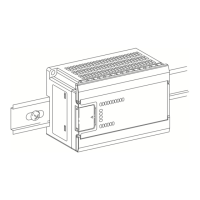
